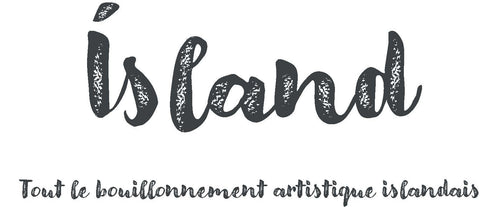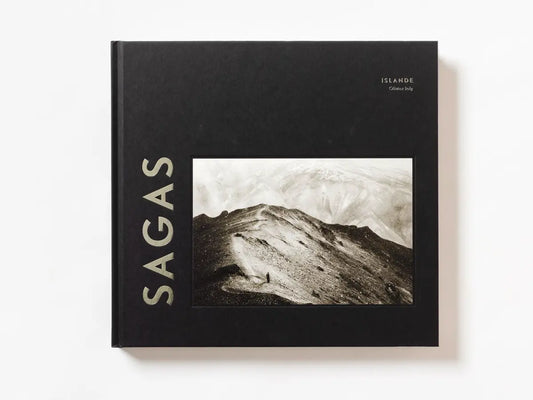Sports journalist and photographer Olivier Joly spent a long time traveling the rather crowded roads of the Tour de France and football stadiums before experiencing the deserted expanses of Iceland.
It was football that first brought him to Reykjavík in 1998, for a match that ended in a 1-1 draw against soon-to-be world champions France, a sort of foreshadowing of the feat that the Icelandic team would achieve by qualifying for the last 16 10 years later.
Since then, Olivier Joly has continued to explore the island, particularly its "highlands," the most remote and arid central part.
He gave an interview to Island.
In 2017, you published your first book, Four Seasons in Iceland, which captured the beauty and diversity of the island's landscapes, particularly their color palette. Why have you since switched to black and white?
Like many travelers discovering Iceland, I was first struck by the beauty of the landscapes, the incredible diversity of colors, the changing atmospheres... sometimes from one minute to the next. It is the strangeness of this universe, both subpolar and volcanic, that I sought to capture in color - and in all seasons. But at the same time, I was already photographing in black and white, like a secret garden. Black and white is more intimate, it suggests more than it shows, gives a hand to our moods. This is how I was able to transcribe my raw sensations. After the publication of Four Seasons in Iceland , I fully took this path of black and white as if I were discovering a new country. In my viewfinder, I no longer saw Iceland as a destination, but as an emotion.
Since 2008, the island has attracted overtourism, saturating certain natural sites and saturating the imagination of Internet users with a host of ever more spectacular images. How do you account for (or not account for) this déjà vu effect that this induces for many of Iceland's most popular sites?
In 2017, I lived in Iceland for eight months with my family. The tourist sites were becoming unattainable for those who, like me, only manage to fully experience this country in a form of distance, solitude, and one-on-one with the elements. So I fled the Golden Circle, the Ice Road, Diamond Beach… and all those marketing names that flourished alongside the tour buses. I turned to less spectacular regions, the forgotten peninsulas, the bare moors, the small lava fields. I got closer to the streams, I took the time to listen to the birds, to feel the texture of the lava and the moss. And then I deepened my knowledge of the Highlands, these wild acres where I rediscover the naked force of the elements, geographical and climatic.
In its second part, your book SAGAS offers snapshots of the daily lives of the inhabitants, largely forgotten in the avalanche of images I mentioned above. These very touching photos capture deep-rooted rituals: swimming in all weather, children playing, a pastor in front of his church... In what circumstances were these photos taken? Are these places where you spent time to "be forgotten," or are they just coincidences?
Throughout my travels, I discovered that this dreamlike land is home to Icelanders, often forgotten, it's true, who have a personality as fascinating as their island. They are bold, creative, resilient, heirs of the first settlers who chose to live here despite the hardships. My friendship with Icelanders, but also my reports, have allowed me to open doors to get closer to these communities who perpetuate ancestral rituals. This is how I came across these children who looked like steaming elves coming out of a hot bath, these schoolchildren running towards the beach at recess time, this icy bather who looks like a giant bird, these farmers who are going to attack the mountains under the snow... With an element of chance, of course, especially since I like to shoot instinctively, handheld.
Indeed, your photos show many scenes of the “rettir,” as the Icelanders call the great gathering of sheep in September… Can you tell us about it?
Every autumn, herders go to the mountains to collect the ewes and young sheep they left there in the summer pastures. To do this, they travel on horseback, on foot, or by all-terrain vehicle to the mountain ranges, valleys, canyons, ridges, and the most remote corners of the island. It's a human and animal caravan that seems to come from another time. It's grueling work, requiring mutual assistance, courage, good organization, and immense energy. Some men, but also some women—because the réttir is very open, like the country—walk more than thirty kilometers a day to chase three animals, accompanied by their dogs. This transhumance is supervised by a man called fjallkóngur, "the king of the mountains," who is the best expert on the region. I followed the réttir in the Fjallabak region for seven years, which allowed me to become known to all those I photographed. They maintain a connection between this land and its inhabitants that is more than a thousand years old. It is this connection that I wanted to capture.
Regarding the musicians Ásgeir and Eric Howden, how did they appear in front of your lens?
I've interviewed Ásgeir several times, for various press publications, and since his first album, which brought him to the world's attention. The last time was at his home in Reykjavik, which allowed me to offer him a photoshoot not far from his apartment, in a little corner of nature, a magical setting of red rocks and birch trees. His song "Going Home" remains my anthem for this country: I immerse myself in it as soon as I set foot on the island. As for Eric Howden, aka Raised by Swans, a Canadian songwriter in love with Iceland, I met him while I was reporting for GEO in the Northwest Fjords. He ran a tiny grocery store in a hamlet and would go out for long walks every day on the cliffs. He's a reserved artist, but we began a friendly correspondence that has continued ever since. His songs are very inspired by Iceland. His album Oxnadalur is named after a valley in the North where he lived, planting 10,000 trees when he wasn't writing and composing.
You've been going to Iceland since 1998, don't you get tired of it ?
Never. First, because nothing is ever repeated: the same place, depending on the seasons, the time of day, the course of the sun and clouds, the rain, can be transfigured. I sometimes guide travelers who love Iceland in the Highlands, and I never stop rediscovering with them this mosaic of volcanoes, deserts, lakes, and rivers. Moreover, I have such a love for this country that I am tempted to take the slightest track, the forgotten path that leads to places I don't know—and there are many. There are also my friends up there, who have become my Icelandic family and that of my daughters. And then, in this country, I feel more alive than anywhere else. It's rare and precious. When I'm not in Iceland, not a day goes by without me glancing at the map on the wall, thinking about my next trip.
Interview conducted on December 20, 2023
Olivier Joly in the media...
The time of a bivouac , France Inter, broadcast on August 12, 2022
Pass me the binoculars : "Iceland, lights of the Highlands", a report by Jean-Marc Chevillard with Olivier Joly, a program on Radio Télévision Suisse, March 24, 2023,
Planet Liza : Olivier Joly, photographer and senior reporter , France bleu, broadcast on June 26, 2022, 39 min,
 Sold out
Sold out Sold out
Sold out Sold out
Sold out























